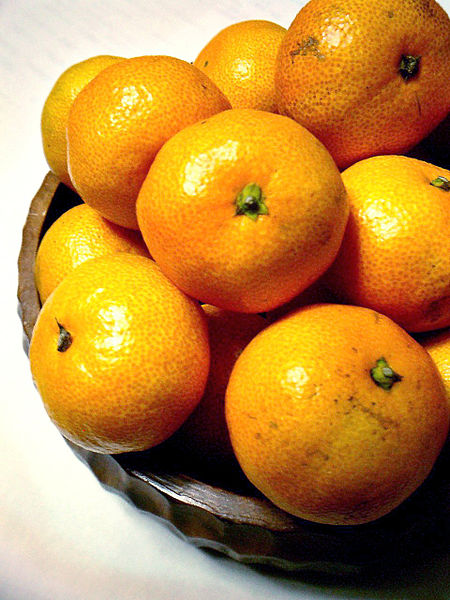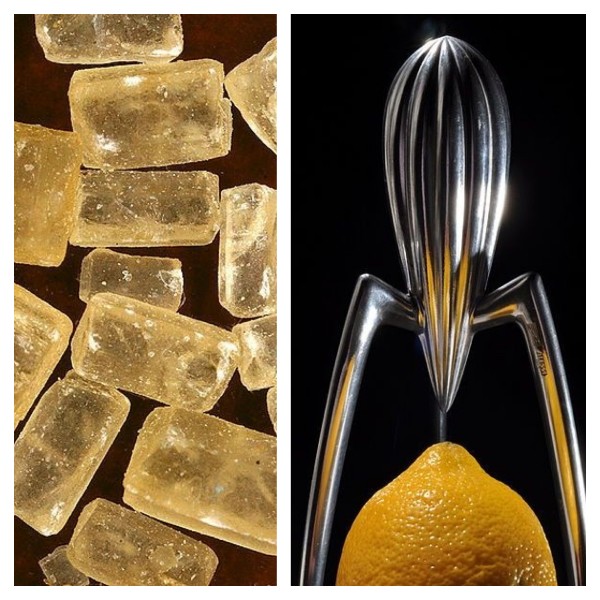People who concern themselves with “consumer acceptability” of fruit know that sugar is a pretty good predictor of how consumers will feel about a given apple or grape or orange; the more sugar (that is, the higher the °Brix level), the more people like the fruit in question. But the °Brix-to-titratable acidity ratio is an even better predictor of general yumminess, which tells us that not just the amount of sweetness, but the balance between sweet and sour (or “fresh,” if you will) flavors determines how we tend to feel about a flavor. That’s the great appeal of Honeycrisp apples: they’re not just sweet, but have a good zing to them, too.
Sweetness and acidity have an intuitive relationship; we know they go together without having to think about it. The sweetness/acidity dynamic is why lemonade is so refreshing, why I add a squeeze of lemon juice to my blackberry preserves, and why high-acidity tomato sauce often gets a few spoonfuls of sugar. Balance between sweetness and acidity is why even people who attest to disliking sweet wines will often enjoy Rieslings (German, Finger Lakes, Ontario, or otherwise) with as much as 3-4% (30-40 g/L) residual sugar; that sugar is balanced out by generous acidity.
Fascinatingly, the International Riesling Foundation’s much-lauded (and very useful) sweetness scale compares wines not on the basis of their residual sugar levels, but on their sugar-to-acid ratio. Wines are “dry” on the IRF scale if they have a sugar-to-acid ratio of less than 1.0. A “dry” wine could, then, theoretically have 12 grams of sugar (1.2% RS) and 13 grams of acid per liter when we’d otherwise perceive a wine with 1.2% RS as at least mildly sweet. An especially low or high pH can bump a wine up or down by one sweetness notch, too.
Why do sweetness and acidity mutually improve each other? I expected this to be a simple question because it’s such a fundamental, innate sort of experience. It’s not a simple question at all. Perhaps I shouldn’t have been surprised; it’s so often the most basic, innate realities that are hard to explain.
There’s evidence that certain acids found in food—citric acid, for example—make certain sugars taste less sweet when they’re mixed together. That makes sense. The confusing thing is that acid doesn’t make all types of sugar taste less sweet; the sweetness of fructose is “suppressed” by acid, but the sweetness of glucose is not. And while glucose makes acid seem less acidic, sucrose doesn’t. With three kinds of acid and up to three major sugars in wine, you can see how complicated these relationships are going to become.
As I mentioned last month, we perceive sweetness because a given sapid (sapid = having taste) molecule is able to bond in very specific ways with the specialized sweetness receptors on our tongues. But acidity doesn’t work the same way. Sourness is like saltiness in being an “electrolytic” sensation; the free protons (H+) that are, by definition, present in an acidic solution literally flow across specialized channels into taste receptor cells, change their electrochemical potential, and trigger the “sour” neuron cascade. It doesn’t look as though sweetness and sourness cancel each other out at the level of taste receptors, then—sour molecules don’t block sweetness receptors, for example—so something else must be happening. What that something else is isn’t exactly clear. It might happen at the level of our neural processing of taste, or there may be something else going on at the level of the taste receptor cells that we don’t understand.**
 It’s often said that acidity in wine is food’s best friend. Characteristically food-friendly wines are usually quite “fresh,” as W. Blake Gray would say, as is especially well-evidenced by the recent trend of pairing Riesling with just about everything. But if sweetness and acidity cancel each other out—at least in part—when they’re both found in wine, why doesn’t the same power dynamic occur in food-wine pairings? In other words, why doesn’t my acidic food make my sweet wine taste less sweet? In my experience the opposite happens, and acidic food makes a sweet wine taste candied and cloying. My best explanation is that the acidic food overwhelms my receptors for sourness so that, when the wine arrives, the sour elements in the wine can’t “register” but the sweet elements still can. The same thing happens with sweet food and acidic wine; the sweet food overwhelms my sweetness sensors so that none of the sweetness in the wine can register. I’d like to see some data supporting or disproving that theory.
It’s often said that acidity in wine is food’s best friend. Characteristically food-friendly wines are usually quite “fresh,” as W. Blake Gray would say, as is especially well-evidenced by the recent trend of pairing Riesling with just about everything. But if sweetness and acidity cancel each other out—at least in part—when they’re both found in wine, why doesn’t the same power dynamic occur in food-wine pairings? In other words, why doesn’t my acidic food make my sweet wine taste less sweet? In my experience the opposite happens, and acidic food makes a sweet wine taste candied and cloying. My best explanation is that the acidic food overwhelms my receptors for sourness so that, when the wine arrives, the sour elements in the wine can’t “register” but the sweet elements still can. The same thing happens with sweet food and acidic wine; the sweet food overwhelms my sweetness sensors so that none of the sweetness in the wine can register. I’d like to see some data supporting or disproving that theory.
Emile Peynaud, in his Le Goût du Vin (The Taste of Wine), spends a few lines on the balancing and negating act between sweetness and acidity and concludes, “these ideas are common enough and there is no need to dwell on them.” Remarkably, it would seem flavor chemists have largely agreed with him.
**Though I’ve searched several databases, it’s entirely possible that I’ve missed important, life-changing contemporary research exploring this corner of flavor chemistry. If I have, I hope that some astute reader will be kind enough to point it out.
[author] [author_image timthumb=’on’]http://palatepress.com/wp-content/uploads/2010/07/yoga-headshot-2010-thumb.jpg[/author_image] [author_info]Erika Szymanski was blessed with parents who taught her that wine was part of a good meal, who believed that well-behaved children belonged in tasting rooms with their parents, and who had way too many books. Averting a mid-life crisis in advance, she recently returned to her native Pacific Northwest to study for a PhD in microbial enology at Washington State University. Her goal, apart from someday having goats, is melding a winery job to research on how to improve the success rate of spontaneous ferments. When tending her Brettanomyces leaves enough time, her blog Wine-o-scope keeps notes on why being a wine geek is fun.[/author_info] [/author]


